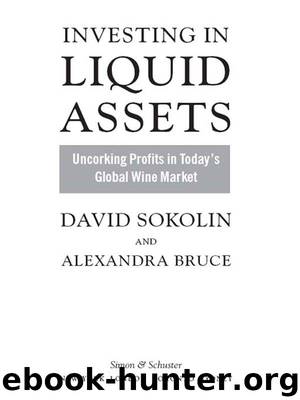Investing in Liquid Assets by David Sokolin & Alexandra Bruce

Author:David Sokolin & Alexandra Bruce
Language: eng
Format: epub
Publisher: Simon & Schuster
Published: 2008-07-15T00:00:00+00:00
Storage at home: Despite the benefits of professional storage, almost every wine investor dreams of having a cellar at home. Even if you plan to store the bulk of your portfolio professionally, there’s a certain attraction to walking into your own cool, dark cellar and seeing all those bottles resting on wooden racks.
There are many options for in-home cellars these days, ranging from refrigerated stand-alone units that can fit in a closet to full-blown, custom-designed showcase cellars to room-sized underground caves specially built with tasting rooms, mood lighting, and dramatic display racks encased in glass. You can spend a few thousand dollars to well over a million, depending on your wants and your budget. Online you’ll find a vast assortment of computer-assisted design programs that help you draft plans for your cellar, then print the design and a materials list, or you can locate builders who specialize in custom in-home cellars.
The cellar must be built right, and that means an airtight, vapor-sealed, and heavily insulated room with a dedicated air-conditioning and humidifying unit to create the proper environment. And that proper environment is a temperature of between 50 and 55 degrees and a relative humidity of between 60 and 65 percent, and no light except for the brief moments you’re in there adding to your portfolio or retrieving a case that you’ve sold. In essence, you want a place a hermit might find cozy.
The absolute no-no in wine storage: a bedroom closet, the garage, or even a basement. Those environments are often much warmer in the summer or much colder in the winter, and the air is often much drier—all very bad for wine and wine corks that expand and contract with temperatures that vary drastically. If those are your only options, then you really must go with a professional storage facility if you want to own investment-grade wine.
The Cellar Log: A Mandatory Back-Office Chore
If you do store your investments at home, make sure that you have a wine-tracking/cellar log program that you follow religiously. As their name suggests, these programs track the wines that come and go through your cellar, recording the costs, quantities, suppliers, and dates of purchase, delivery, and sale, among other items. These categories are a must. The cleaner, more accurate your records are at the time of sale, the better the provenance of your wine and the greater its value.
You don’t have to spend a ton of money on one of these programs, though you certainly can. Some of them cost thousands of dollars and are based on a bar-code system that prints small labels for each bottle or case so that the program can track location within the cellar and other sundry variables. If you don’t want to go to that extreme, use one of the most effective and readily available tracking tools that most people already own—a computer spreadsheet program like Microsoft Excel. All you need do is build a simple spreadsheet that tracks those key notations mentioned above. Then keep all your
Download
This site does not store any files on its server. We only index and link to content provided by other sites. Please contact the content providers to delete copyright contents if any and email us, we'll remove relevant links or contents immediately.
| Buying Guides | Cellars |
| Champagne | Collecting |
| Spirits | Whiskey |
| Wine | Wine Pairing |
| Wine Tasting |
World's Best Whiskies by Dominic Roskrow(42447)
101 Whiskies to Try Before You Die by Ian Buxton(42446)
Whiskies Galore by Ian Buxton(40873)
Craft Beer for the Homebrewer by Michael Agnew(17489)
Right Here, Right Now by Georgia Beers(3534)
Not a Diet Book by James Smith(2769)
Water by Ian Miller(2617)
The Coffee Dictionary by Maxwell Colonna-Dashwood(2566)
Kitchen confidential by Anthony Bourdain(2345)
Coffee for One by KJ Fallon(2035)
Smuggler's Cove: Exotic Cocktails, Rum, and the Cult of Tiki by Martin Cate & Rebecca Cate(2015)
Beer is proof God loves us by Charles W. Bamforth(1956)
Superfood Smoothie Bowls: Delicious, Satisfying, Protein-Packed Blends that Boost Energy and Burn Fat by Chace Daniella(1937)
Talking as Fast as I Can by Lauren Graham(1873)
Bourbon: A Savor the South Cookbook by Kathleen Purvis(1820)
A Short History of Drunkenness by Forsyth Mark(1748)
Eat With Intention by Cassandra Bodzak(1713)
Cocktails for the Holidays by Editors of Imbibe magazine(1653)
Colombia Travel Guide by Lonely Planet(1646)
